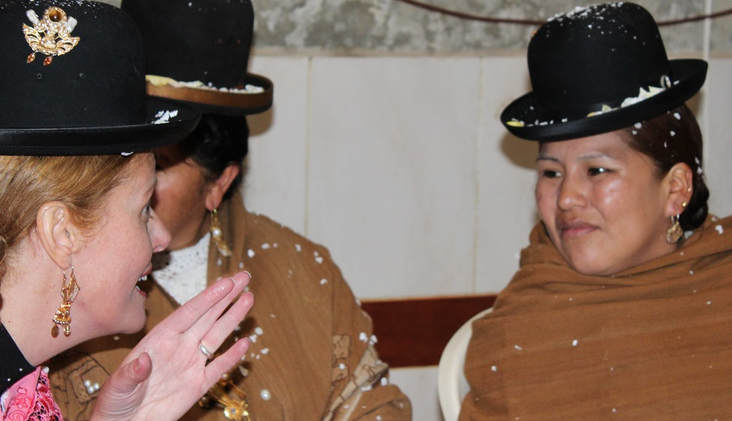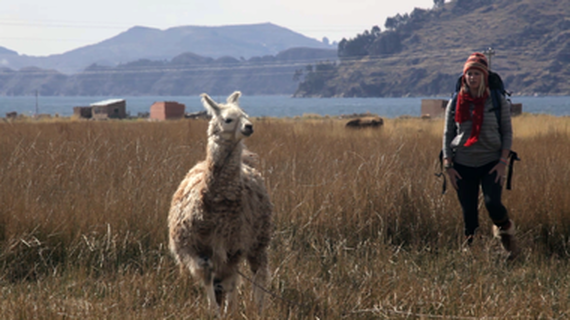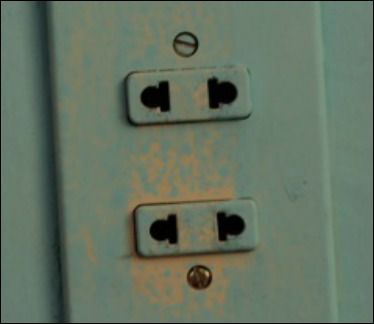THE COOLEST GUIDE YOU'LL EVER FIND TO COPACABANA
(WHICH MIGHT BE SAYING SOMETHING IF COPACABANA WERE REALLY COOL)
|
I'm a travel author who has spent a third of her life in Latin America. I wrote this guide after living in Copacabana for three years and after having spent twelve years in Bolivia. Have a great trip! For more information on Bolivia, write to me at parenthesescabins at gmail dot com. For more info on staying at our cabins, click here. Also if you have comments or corrections to this guide, please send them my way. |

I think the joke I'm telling is really funny. Obviously, the punchline is getting lost in translation.
|
 The side of Copacabana rarely seen by tourists.
The side of Copacabana rarely seen by tourists.
BASIC GEOGRAPHY
Copacabana is a town with a dual identity.
One half consists of a tourist and shopping section. The beach sector and 6 de Agosto Street offer restaurants, bars and cafes, many of which are located on the shores of Lake Titicaca. Along 6 de Agosto, you'll also find lots of shops with jewelry and traditional Bolivian handicrafts. Near the central plaza, you'll encounter the Mercado Central, a traditional market where you can buy meats, produce and other staples.
The other half of Copacabana retains its traditional Bolivian identity and is populated with villagers in traditional dress who tend to earn their living raising livestock (primarily sheep, cattle, and pigs) and growing potatoes, fava beans, quinoa, and a legume called "tarwi" cultivated since Incan times. Most tourists never see this side of town (it's where our rental cabins are located) though I recommend it highly as it offers a glimpse into another culture, a true "experience" for travelers in search of such things. To get there: Walk downhill from the main plaza (away from the beach) and keep walking. The further you go, the more rural and traditional the landscape becomes.
GETTING TO COPACABANA
The two closest airports are La Paz (Bolivia) and Juliaca (Peru). From either airport, your only option for continuing on to Copacabana is via land, a three- to five-hour trip.
 Most outlets in Bolivia look like this. The electricity runs at 220 V.
Most outlets in Bolivia look like this. The electricity runs at 220 V.
INTERNET, ELECTRICITY & OTHER NECESSITIES
Internet: You won't be thrilled with your internet connection here. Lots of hotels have wi-fi, but I've found the lines get overloaded when the hotel has say, more than one guest, and I've had trouble even accessing my email account. One option is to visit one of the two internet cafes in town with a decent internet connection. There're not cafes in the traditional sense - there is no coffee or beverage service of any kind - they simply offer desks with computers and a high-speed connection, that works well enough except when the internet cafe is packed and the guy next to you is watching his cousin's cat video on Youtube.
The two cafes are owned by two brothers and you can find them by locating the signs that say simply "Internet" in rainbow-colored letters. Both of the cafés are on 6 de agosto Street. One of the cafes is half a block up from Plaza Sucre. The other one is three-quarters of a block up from the lake. (The reason this is the best public internet in Copacabana is that the brothers pay for a bootlegged connection from Peru.) I strongly suggest not even trying any other internet place in town as they are simply an exercise in wasted time and frustration.
Electricity: Electricity is 220 V in Bolivia. You rarely need to adapt your plugs, as Bolivian outlets take round pins (European) and flat ones (American) too. I've read some sites that claim that electricity runs at 110 V in La Paz, which is almost entirely inaccurate. When electricity was first installed there, this was the case, but all houses constructed in the past few decades are 220 V and even those that were originally installed with 110 V have additional outlets that were installed later with 220 V (these older houses have two different kinds of outlets, which are always marked). So think 220 V and you'll be fine.
Copacabana has a teeny tiny electricity problem, which I haven't discovered the root cause of. All I know is that the electricity goes out once or twice a month for several hours (up to eight). They have programmed outages which they announce on the radio, but they tend to announce these things at 7 am, before I've had my morning coffee so I tend to figure out what's going on once my TV screen goes black. To be prepared, be sure your computer battery is charged at all times and once it runs out, think of hiking up to the Calvario or taking a stroll along the lake.
Water. If you think the electricity problem is bad, you don't even want to know about the water. Ironic, for a place surrounded nearly entirely by a lake. But there's a severe water shortage in the city, with city water running only half an hour to several hours each day. You probably won't notice this problem, however, as most hotels have water tanks with reserves. Though it'd be nice of you to be a little water-conscious anyway.
Hot showers: It's hard to find a shower in Copacabana that isn't heated by electricity. Your showerhead will likely have a big electric heater attached. And your shower will only have one knob. The more you turn it to the right, the higher the water pressure and the less hot your shower. The less water you let through, the warmer it will be. It's not the greatest shower situation, I admit. In the future, we're looking into solar-heated water for the showers in our cabins. Stay tuned.
FOOD IN COPACABANA
Breakfast: Along 6 de Agosto Street, you'll find cafe after cafe offering "American" breakfasts, trying to entice you with pancakes, waffles and omelets. I've invariably found these places leave much to be desired, but in a pinch, they work to take away your hunger pangs.
For a different option, go to where Bolivians have their breakfast: the Central Market. It's packed on weekends, and the earlier you get there, the better. Women sit over boiling vats of oil and toss in rings of pastry, which they fry and then top with sugar cane syrup (a more refined form of molasses). They're super-cheap. A dozen "buñuelos" will run you less than a dollar. They're tasty too if you're willing to ignore the carbs and fat.
Buy your buñuelos from the women in the middle of the room and then head toward one of the beverage stalls with your breakfast. Once you've seated yourself on one of the benches, ask the woman for coffee, café con leche or api, a traditional Bolivian drink made from corn and sweetened with sugar. Don't feel bad about eating food you bought from another vendor. Everyone does it. So that makes it okay.
Lunch: This is the most important meal in Bolivia and it always includes a soup course and an entree, and usually a dessert or a refresco (a beverage made from spices or fruits). Most restaurants offer a choice of two or three options that change daily.
Start at the main plaza and walk down 6 de agosto toward the beach and you'll see restaurants on both sides of the street, with signs advertising the day's choices. Most places charge between 15 to 40 bolivianos ($2 to $5.50) though don't take price as an indicator of quality. I find that the more expensive places try and "fancy up" their food to appeal to foreigners, but the end result is bland and boring. (For instance, iceberg lettuce is considered sophisticated here whereas a tasty Bolivian salad of carrots and beets is not.)
One other option: Visit the central market ("el comedor del mercado central"). There you'll find different soup and entree options at each stall. I recommend the "chairo," a typical Bolivian soup made from freeze-dried potatoes called chuño. (The lunch section of the central market is located next-door to the breakfast section. However, they are two separate structures.)
Dinner: Dinner is similar to lunch: soup followed by an entree, with several options to choose from. Most travelers select one of the restaurants located on 6 de agosto.
THE MONEY SITUATION
Bringing cash: If you’re going to do this, bring large bills. The exchange rate is better for $100 bills versus $20 bills. Also, if there is the slightest tear on the bill, no one will accept it. Bring new, unblemished currency.
The advantage to bringing cash is a better exchange rate than what you’ll get at the ATMs. It seems that my stupid bank adds a percentage charge for withdrawing in bolivianos (on top of the five dollars they charge me for withdrawing in a foreign country) so I try to withdraw in dollars and then go to a cambista (also called a casa de cambio) to get our dollars changed into bolivianos. Cambistas in La Paz offer a better rate than banks and I’ve never gotten a fake bill though it's only worth it when changing a sizeable chunk of cash or if you are very cheap. Otherwise it may not be worth the bother.
The cambistas in La Paz offer the best rate (currently 6.95 compared to 6.85 in Copacabana) so if you get the chance, change your money before you come. Banks in Copacabana will change your money too, but they close at 4 pm.
Obviously, the disadvantage to bringing cash is the possibility of being robbed. Though I have to say, Bolivia is the safest country I have ever been to when it comes to street crime. Don’t be nervous but take reasonable precautions.
Withdrawing in dollars from an ATM in La Paz: Most ATMs in La Paz and all of the ATMS in Copacabana only offer bolivianos. Your only option for withdrawing in dollars in La Paz is on Calle Comercio (the one exception are ATMs for BISA, but they only offer $20s, which get a lower exchange rate). I'm partial to Banco Mercantil Santa Cruz, but only one of their ATMs has currency in dollars (true of most or all banks on Calle Comercio). When you walk into the bank, go to the row of ATMS on the right-hand side, and choose the ATM in the middle (there are three). Whatever bank you go to, ask the security guard to point you to the ATM that has dollars: ¿Para retirar en dolares? There will definitely be a security guard there. You will recognize him because he’s the guy holding the ginormous shotgun.
In general, Calle Comercio is the main banking street (and it's only about three blocks long so it's hard to get lost) - there are banks along all of it.
Changing your money in La Paz: There is a good place on the corner of Plaza San Francisco. It’s on the corner of Mariscal-Santa Cruz and Sagarnaga. Really, any place will do as long as they give you an exchange rate of 6.95 per dollar. There are lots of places on Sagarnaga Street too and a few along the Prado. Any casa de cambio or cambista will give you a better exchange rate for hundred dollar bills versus smaller ones. Some places won’t even exchange $5s and $1s.
There are also freelance cambistas on the street. I’ve never been ripped off by them (resorted to using them on Sundays when the casa de cambio offices are closed) but I’ve always felt nervous handling money on the street.
Exchanging dollars in Copacabana: You can exchange dollars here. The rate is lower than it is in La Paz, however: 6.85 versus 6.95. Most of the stores on 6 de agosto will change your money as will the banks, though the banks close at 4 pm.
ATMs in Copacabana: You’ll only be able to withdraw in bolivianos. But there are a few ATMs in town that I’m sure will accept your card. This is the low-hassle, most-expensive solution. In the main plaza, there is Banco Los Andes and on 6 de agosto, you'll find FIES. Banco Union only takes VISA, not Mastercard debit cards, but it's located on the street parallel to Banco FIES. You'll also see Prodem, but don't even bother as the ATM only services Prodem customers.
ATMs in Peru: Whatever you do, do not withdraw from a Peruvian ATM. (I only mention this because we’re so close to the border.) The charge is $13 per withdrawal, even if you withdraw in soles and you won't be able to withdraw more than the equivalent of a hundred dollars. That’s a ridiculous percentage! So if you plan on spending any time in Peru, bring dollars in cash and then exchange them at a bank in Peru. (You don’t want to withdraw bolivianos from an ATM in Copacabana because to change them to soles, you lose twice on the exchange rate. Remember, ATMs in Copacabana do not dispense dollars.) In short, if you want to spend any time in Peru, bring dollars, unblemished bills. (Unlike Bolivians, Peruvians seem to be fine with small bills.)
Once you have your bolivianos: You want large bills when it comes to dollars, but small bills in bolivianos. Most tiendas won't accept large bills for small purchases. The owner will simply give the bill back to you and refuse to sell to you.
I always try and get rid of my hundred-boliviano bills when making largish purchases. So if I spend 40 or 50 bolivianos on groceries, the owner usually will give me change on a hundred. Basically, any time you make a purchase over 40 bolivianos, get rid of those hundreds. And try and keep your coins too until you really need them as you'll find they're scarce in Bolivia.
When in a pinch, all banks are legally required to give you smaller bills in exchange for your larger ones. There will be a security guard at the entrance, who may look at you strangely, but tell him, "Quiero fraccionar mis billetes." He should give you a numbered ticket and when your number shows up on the TV screen above, go to the appropriate cashier.
Another great option is to spend large bills at grocery stores (but this is only possible in La Paz and other large cities in Bolivia such as Cochabamba and Santa Cruz). Grocery stores are the one place I've found that are happy to accept large bills even for small purchases. They'll even let you pay in dollars and the exchange rate is really good! However, expect to pay more for everything you find at the grocery store than you would at the open-air market.
LANGUAGE
You'll have a much better time if you speak some Spanish. Few people in Copacabana speak English other than the tourists.
You'd have an even better time if you were fluent in Aymara, the native language spoken in Copacabana and La Paz, but I only know how to say a few phrases and I invariably pronounce them badly. You'll do fine with just Spanish. Even Bolivians whose first language is Aymara speak fluent Spanish (with the rare exception of very old people who probably didn't get past elementary school). However, people in Copacabana may switch to Aymara when talking about you to their friends. You can be sure they're not saying anything very flattering. I have yet to learn to say, "Screw you" in Aymara, but it's on my to-do list.
